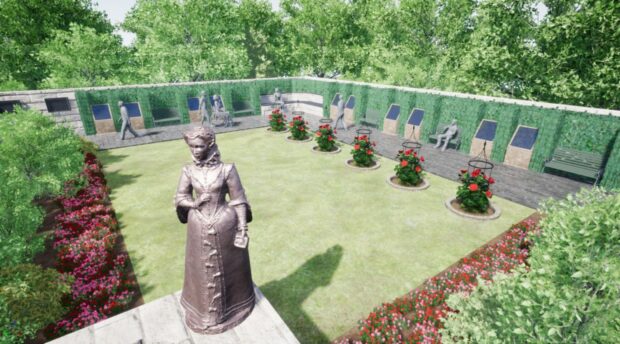A Fife artist who refuses to remove a controversial art installation in his front garden has compared objectors to ‘stalkers’.
Denis Carbonaro has hit out after hundreds of people on social media condemned the artwork outside his home, which he refers to as Bark Park, on Strathbeg Drive in Dalgety Bay.
It’s the latest twist in a long-running saga, which recently has seen locals claim the ‘Dalgety Baycott’ artwork is making it hard to sell neighbouring homes.
Hundreds of people have taken to social media to complain, while more than 1,000 people have signed a petition calling for Fife Council and Police Scotland to “put a halt to this so-called fly-tipping and classing it as art”.
One critic said: “It’s hilarious that the authorities are pandering to this. He’s not an artist or anything else.”
Another said: “It’s a shame for the neighbour who was trying to sell their home.
“What a mess and definitely not art. Walked past it at the weekend expecting him to come out and shout at us.
“Surely council can do something as a fire and vermin hazard.”
Another commented: “He’s been watching too much Turner Prizewinning ‘art’ – it isn’t art and neither is this in my opinion.
“A magnet for vermin and littering by others.”
Denis Carbonaro compares objection of artwork to stalking
Mr Carbonaro, also known as the Hippy Artist previously claimed: “The silent and peaceful ‘visual noise’ of this campaign cannot be labelled as antisocial behaviour, nor is it breaking any laws.”
Now, he has compared the public interest to stalking.
He told The Courier: “The Bark Park story is an ongoing study, and while it’s not yet fully complete, it reveals a unique form of public stalking that I’ve experienced here at Bark Park.
“Large numbers of uninvited visitors justify their intrusive behaviour through a series of false narratives.”
Mr Carbonaro claims he has observed six traits from visitors which mirror classic stalking behaviour.
He says these include “the illusion of a reciprocal relationship”, adding: “Just like traditional stalkers, many visitors believe they have a right to return because they “might one day contribute,” ignoring the fact that they’ve never done so.”
He also claims to have observed “rationalising control”, describing this as: “Some visitors, like stalkers, convince themselves that they have the right to monitor and control the situation for my supposed benefit.”
Artist claims community feel entitled to ownership of his art
He says visitors “dismiss the negative effects of their presence, much like stalkers who downplay their actions” and have a “false sense of entitlement driven by community pride”.
He explains: “In the early years, Bark Park became a source of pride for the community, leading people to believe they had ownership over it.”
Mr Carbonaro also added that objectors are perceiving his unwillingness to remove he art as a challenge, and that “when boundaries are set, some visitors, like stalkers, see rejection as a challenge to overcome.”
Finally, he accused visitors to his art as “like stalkers” who “develop a distorted sense of reality, misinterpreting my creative work as an open invitation.”
What do you think of Mr Carbonaro’s ‘Dalgey Baycott’ art? Let us know in the comments.













Conversation